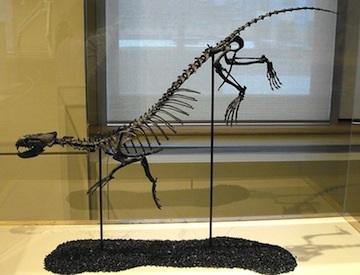340914-into the water.jpg

Puijila darwini skeleton Credit: Kevin Guertin, Creative Commons Attribution- Share Alike 2.0 Generic
An evolutionary “missing link” toddled across the chilly landscape of northern Canada at least 20 million years ago. It used its strong limbs and big teeth to devour a duck and a small rodent — its final meal. After it died, it was buried in the sediments at the bottom of a lake. It wasn’t seen again until 2007, when researchers discovered its fossilized skeleton.
Puijila darwini was about three-and-a-half feet long, with a head that resembled a modern-day seal and a body that resembled an otter.
It was well adapted for getting around on both land and water. It had powerful front legs and shoulders, which would be good for both running and swimming. It had webbed feet and a streamlined body, indicating it spent a lot of time in the water. It also had big eyes, which would be good for seeing under water. And it probably had whiskers, which would be good for feeling around for food near the bottom.
So Puijila — a name that means “young sea mammal” — was classified as a relative of modern-day pinnipeds — seals, walruses, and sea lions, which use flippers to propel themselves through the water.
Puijila isn’t an ancestor of today’s pinnipeds, though — it’s more like a cousin. Instead, Puijila and the pinnipeds probably share a common ancestor. It demonstrates that pinnipeds likely evolved from land mammals that began spending more and more of their time in the water — first in freshwater lakes, and later in the oceans — the graceful cousins of an ancient missing link.

